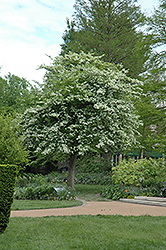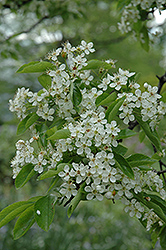Height: 30 feet
Spread: 30 feet
Sunlight:
![]()
Hardiness Zone: 4
Description:
An all around lovely tree with a round shape, attractive foliage, flowers, berries and bark; bark exfoliates to show orange underlayer; red pomes attract birds and butterflies; edible fruit can be made into wine and preserves; watch out for the thorns
Ornamental Features
Green Hawthorn is bathed in stunning clusters of white flowers held atop the branches in late spring. The fruits are showy red pomes carried in abundance from early to late fall. It has dark green deciduous foliage. The serrated pointy leaves turn an outstanding brick red in the fall. The peeling gray bark adds an interesting dimension to the landscape.
Landscape Attributes
Green Hawthorn is a deciduous tree with a more or less rounded form. Its average texture blends into the landscape, but can be balanced by one or two finer or coarser trees or shrubs for an effective composition.
This is a relatively low maintenance tree, and is best pruned in late winter once the threat of extreme cold has passed. Gardeners should be aware of the following characteristic(s) that may warrant special consideration;
- Insects
- Disease
- Spiny
Green Hawthorn is recommended for the following landscape applications;
- Accent
- Shade
Planting & Growing
Green Hawthorn will grow to be about 30 feet tall at maturity, with a spread of 30 feet. It has a low canopy with a typical clearance of 5 feet from the ground, and should not be planted underneath power lines. It grows at a medium rate, and under ideal conditions can be expected to live for 70 years or more.
This tree should only be grown in full sunlight. It is very adaptable to both dry and moist growing conditions, but will not tolerate any standing water. It is not particular as to soil type or pH. It is highly tolerant of urban pollution and will even thrive in inner city environments. This species is native to parts of North America.

